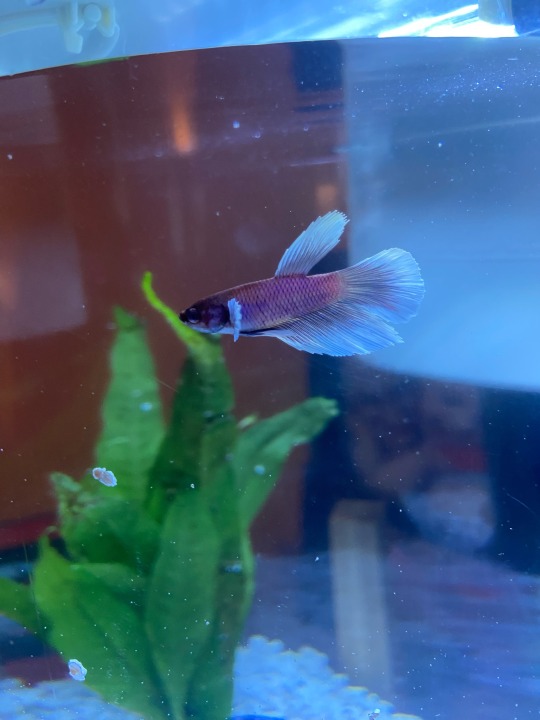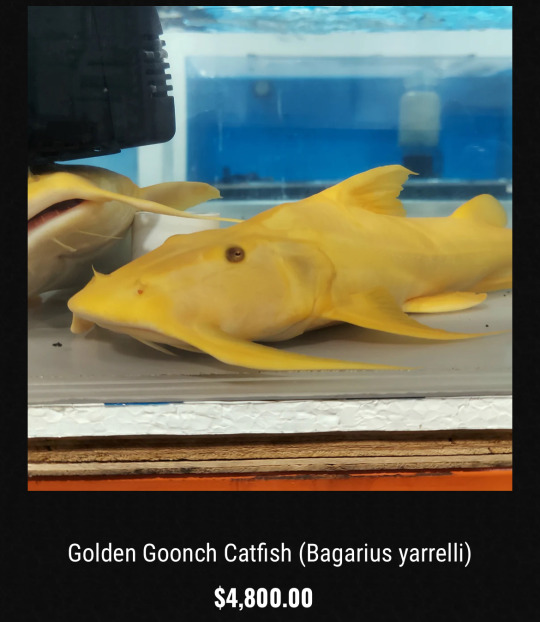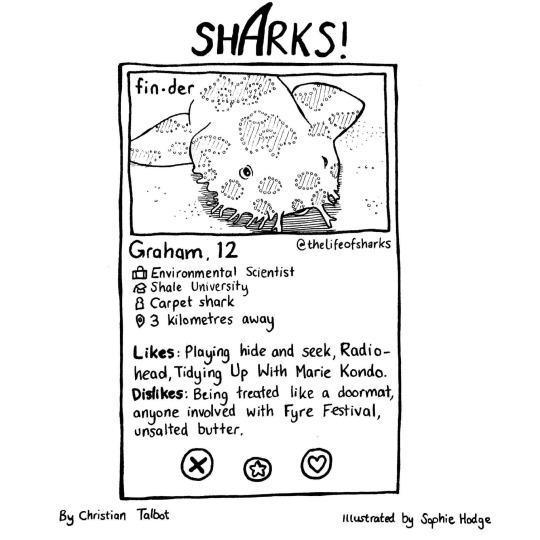Note
Do you have a favorite species of shark?
Hi there! I do :) it's the zebra shark!

They're just so beautiful :) One of my favorite things from being an aquarist intern was feeding a trio of them! They are target trained, and they inhale big slabs of fish out of the tongs you hold out for them with their teeny mouths. Big dorks.
I also think it's fascinating that they are thought to be the closest relatives to whale sharks!

You can see a resemblance between these two pictures when you check out their double dorsal fins, sloping back, and pronounced longitudinal ridges!

They are also just the sweetest babies - and in captivity, these sharks often perform parthenogenesis, which is when females basically pup their own clones without the need for a male!
Lemme know your favs in the comments 🦈🤘
#zebra shark#stegostoma tigrinum#chondrichthyes#elasmobranchs#marine biology#marine bio#marine biology studyblr#marine bio studyblr#biology#zoology#marine life#animals#aquarium#shark#sharks
41 notes
·
View notes
Text
This school of scalloped hammerheads was not a sight we expected to see, but what a sight it was! Experts are actually unsure why scalloped hammerheads school, but some theorize they school this way as juveniles, and continue the behavior into young adulthood!
#hammerhead shark#scalloped hammerhead#sharks#chondrichthyes#elasmobranchs#marine biology#marine bio#marine biology studyblr#marine bio studyblr#biology#zoology#marine life#animals#scuba diving#marine conservation#ocean
1K notes
·
View notes
Text
🌑 Black beauty! This manta is an example of the uncommon melanistic manta - a color mutation that results in more dark pigmentation than normal (like the opposite of albinism, which is a lack of pigmentation!) It lacks the white chevron on its back and white belly, making it truly striking.
#manta#melanism#socorro#marine biology#chondrichthyes#elasmos#mobula birostris#marine bio#marine biology studyblr#marine bio studyblr#biology#zoology#marine life#animals#sea life#ocean life#ocean#scuba#scuba diving
89 notes
·
View notes
Text
People who see pics of like those fucked up deep sea fish and creatures and go "omg I'm never going swimming in the ocean again 😰😰😰" calm down. They're 5000 feet below where you are and also i went down there and none of them even knew you. Leave them alone bitch
72K notes
·
View notes
Video
Source is SHARKEEE ON TWITTER who posts tons of original amazing wildlife shots and videos but I needed to show you what lamprey look like mating, you won’t regret it especially not when one of them is still so worked up it starts swinging a boulder around with its face
10K notes
·
View notes
Text
While researching for upcoming fish facts I ended up going down a rabbit hole on parrotfish teeth, and I need to share this information in another form than just a fish fact. This stuff is unbelievable. You know the beak of the parrotfish, right? It's formed from the fused teeth of the parrotfish, as an adaptation to have ample biting surface to scrape off and chew on coral, their main food source.

A close-up of the beak of a parrotfish. It has this honeycomb pattern which I find very cool.
Well. To constantly chew on coral, they must have some pretty hard teeth, right? And they indeed do: the teeth of the parrotfish are made up of a mineral called fluorapatite, which forms intricate, chainmail-like woven structures on a microscopic level. Fluorapatite just so happens to be the second hardest biomineral found. This stuff, the parrotfish's teeth?? They are stronger than copper, silver and gold. That's crazy, right!!?? A square inch of the parrotfish's teeth can withstand a whopping 530 TONS OF PRESSURE!! That's the weight of 88 ELEPHANTS on top of a single square inch!!!! The only biomineral that is tougher is the teeth of chitons, that is the single tougher thing in the whole world!!! Not only that, but the stiffness and hardness of the teeth increases the more we get closer to the tip (as the mineral fibers get closer and closer to one another), the very tips of the teeth even surpass the chiton teeth in stiffness!!!

Here are pictures produced through a process called PIC mapping, which shows the size and orientation of crystal fibers at the tip of the teeth.
That feels like it shouldn't be right, no? You'd think that the toughest biominerals in the world would belong to, like, the skull of an animal that rams into rocks or maybe the shell of some animal, not the teeth! The teeth of chitons and parrotfish out of all animals no less! Who would've guessed that the diet of "rock animal" would make the parrotfish require some of the toughest dentition the world has ever seen, huh? That right there is one super good reason why you should never stick your finger in the mouth of one.
Every day I am blown away by how amazing fishes are....
8K notes
·
View notes
Text
Oceanic manta rays are the largest species of ray in the world, with a wingspan of up to 26 feet. Despite their immense size, they are completely harmless to divers - they have no barbs to speak of, unlike stingrays, and spend their time filtering the water for plankton with the help of their cephalic lobes (the big paddles on each side of their mouths). Socorran mantas have grown very used to divers, and often seek out our bubble curtains seemingly because they feel good and may help clear away parasites!
#manta#mobula birostris#endangered#dive footage#scuba#marine biology#marine bio#marine biology studyblr#marine bio studyblr#biology#zoology#marine life#animals#sea life#elasmobranchs#chondrichthyes#manta ray#socorro#mexico#cute animals
248 notes
·
View notes
Text
A close encounter with a very scarred individual! This is potentially a male, evidenced by the heavy rake marks down his body (it is often assumed more heavily scarred dolphins are male due to mating competitions), though it is possible these scars were caused by his environment at some point. Also of note are his parasites - if you look closely at the edges of his pectoral and caudal (tail) fin, you can see what almost looks like fringe. These are actually dangling parasites, likely Xenobalanus globicipitis, which is actually a kind of elongate barnacle!
Bonus: if you look closely, a black manta makes a low fly-by in the background
#bottlenose dolphins#parasites#marine biology#marine bio#marine biology studyblr#marine bio studyblr#biology#zoology#animals#aquarium#cute animals#dolphin#sea life#marine life#scuba diving#whales#porpoises#wildlife#adventure#travel
107 notes
·
View notes
Text
This week, I got to dive the Revillagigedo islands! These islands, the largest being Socorro, are hundreds of miles off the coast of Mexico and are known for attracting pelagic (open-ocean) life. One of the main populations here are bottlenose dolphins, and as you can see, we received a warm welcome! As bottlenose dolphins can live around 50 years or more, it's likely some of the older dolphins have been greeting divers in this way for decades!
#many more videos to come#dolphins#marine mammals#scuba#socorro#mexico#scuba diving#marine biology#my video#bottlenose dolphin#porpoise#biology#zoology#travel#cute animals#animals
19 notes
·
View notes
Text
Meet the extraordinary bone-eating worms: no eyes, no legs, no mouth, no stomach—no problem!
These deep-sea tube-dwellers have mastered the art of feasting on the bones of sunken whale carcasses. They secrete acid that dissolves the bone, while symbiotic bacteria aid in digesting the organic material, providing a unique food source for these fascinating creatures.
Our partners @mbari_news discovered these incredible worms more than two decades ago, and with their help, we’ve been able to bring them to our Into the Deep/En lo Profundo exhibit.
2K notes
·
View notes
Text

I don't get to see my pygmy corydoras too often, as they are my nocturnal crew in my interspecies neon tetra tank, but every so often they do cute shit like hang out together on the anubias 🌿
#i lost one recently to an issue i couldnt identify that seemed almost neurological#so especially happy to see some others doing well!#also#the white dots are nerite snail eggs so please dont ask lol#aquaria#pygmy cory#corydoras#planted tank#freshwater aquarium#marine biology#marine bio#marine biology studyblr#marine bio studyblr#biology#aquarist#fish keeping#aquarium#animals#cute animals
21 notes
·
View notes
Text
I wonder what the largest shellfish is?
22K notes
·
View notes
Note
hi , not to hijack your blog with my problems , but i was wondering if you could help me with something ? im not going to ask for money i promise
my family recently got a beta . weve had betas several times before , this isnt a first time thing . but this one just kind of …. floats at the top of the tank .
hes not dead , hes never gone belly up , and he moves around the rest of the tank sometimes . we got him a heater and food that he could fit in his mouth and everything - he still liked floating at the top of the tank , like hes sleeping . is this normal ? or is there something we should do ?


this is him btw
sorry again and thank you so much for listening to me
Hi there! Floating near the top of the water can mean a few things- the first is that the water could be poorly oxygenated, and so he stays near the surface to more easily "gulp" more air. Hopefully you have a filter? Bettas generally do not lead good lives in conditions without one. The second is it could be a swim bladder issue, which should be fairly easy to confirm or rule out. When your fish swims lower into the middle of the water, does it seem like it is fighting to get away from the surface, and is it "buoyed" back up like it has on a life jacket? If this is the case you must treat it using additives to the water - there are few different methods and I encourage you to research those on your own, but I will say do NOT trust Bettafix (I've had terrible experiences in the past and in general the fish keeping community seems to agree using it is not worth the risk. Usually more of a skin/fin treatment anyway but it is still sometimes touted to fix swim bladder issues).
The third is simply that your betta could be bored - betta like to rest on things or wedge themselves in places where they'll be held still. If your tank is a little sparse, it could be that it's just easiest to "rest" against the surface. Betta come from crowded environments teeming with plant life, so I say to the best of your ability, pack in the plants or add driftwood that is arched that gives your betta something to swim beneath (just make sure any rough areas he could tear his fins on are trimmed or sanded away).
Really hope this helps! Best of luck :)
13 notes
·
View notes



